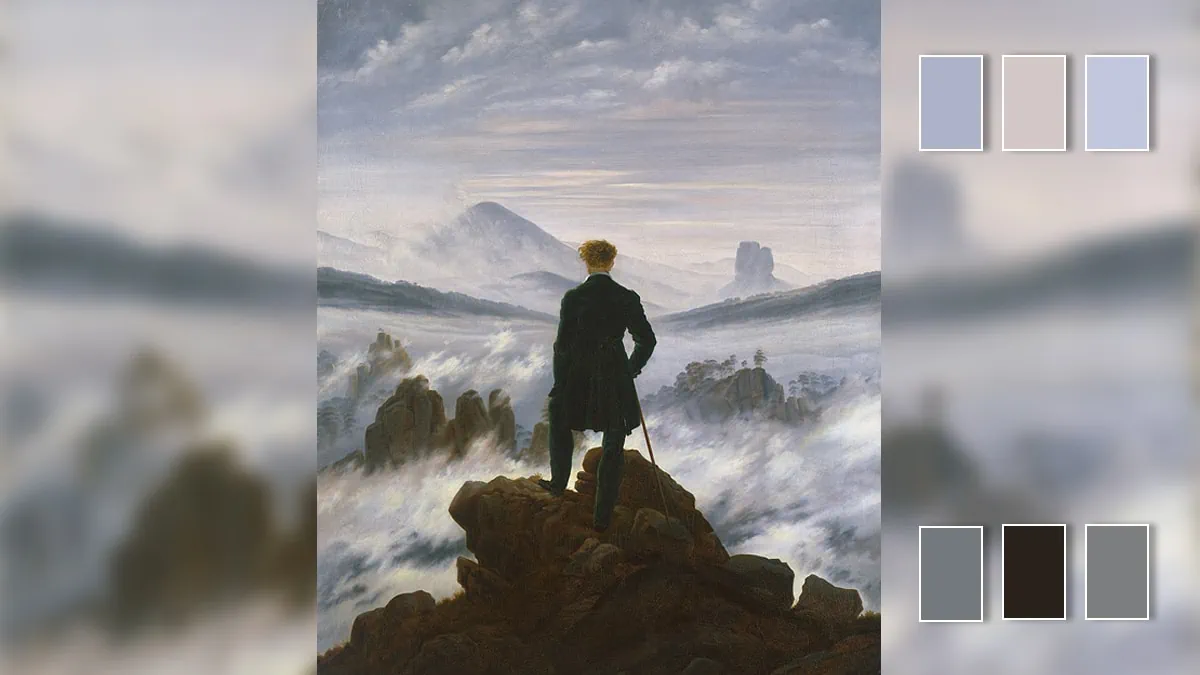Over 33 popular historical and fictional books have used Wanderer Above the Sea of Fog as their cover.
Isn’t it a big milestone?
Even if it is, you’ll be surprised to know that Caspar’s Wanderer art never received attention or massive praise from critics when its artist was alive.
It was overlooked and purposely kept away from the limelight for years.
Caspar, who put his blood and sweat into it, didn’t give much importance to critics; he made wanderer art to express himself and demonstrate his admiration for nature.
Although it never garnered attention from people, which it deserved, it became the most talked about Romanticism artwork in its later years.
But how? What exactly happened after Caspar’s death that made his art the most famous Romanticism art?
Today we’re going to talk about that, as well as learn how Caspar’s Wanderer painting was made and who the real subject was, as it has also remained a topic for discussion for years.
Table of contents
A Tale of Caspar David Friedrich, Romanticism, & Wanderer Art!
Before we jump straight to knowing how Wanderer above the Sea of Fog was made, let’s learn who Caspar was and how he was associated with Romanticism.
Born on 5th September, 1774, Caspar was a prolific Romanticism painter from Germany.

He studied art from 1794 to 1798 at a reputed art school and became a full-time painter after moving to Dresden.
He learned extensively about art from experienced painters like Philipp Otto and Runge, who helped him improve his craft.
Although Wanderer artist Caspar learned art during his childhood days, his style matured after conceptualizing a landscape piece called The Cross in the Mountains.

His admiration for nature was evidently seen in his work, which primarily focused on stillness and isolation.
Dozens of reasons brought Caspar closer to Romanticism; one of them was his melancholy past.
As we know, Romanticism was about denouncing traditional painting techniques and focusing on emotions.
Caspar, who had gone through tough times during his childhood, sought solace in Romanticism art in record time.
His earlier days were filled with agony and sorrow.
He saw his loved ones die. First, his mother, who died when he was seven, then came his two sisters and later his brother, who died after falling on a frozen lake while saving Caspar’s life.
Being introduced to Romanticism, Caspar produced a series of paintings that had a dark, dull, and melancholy tone.
Most remained away from the limelight, including Wander Above the Sea of Fog.
Suggested Read: Famous Roman Paintings
Wanderer above the Sea of Fog Overview
| Painter | Caspar David Friedrich |
| Date of Creation | 1818 |
| Genre | Landscape |
| Art Movement | Romanticism |
| Medium | Oil on Canvas |
| Dimension | 94.8 cm × 74.8 cm (37.3 in × 29.4 in) |
| Owner | Hamburger Kunsthalle, Hamburg, Germany |
Composition
The art is made from a vertical perspective with oil medium.
It features a man with his back to the viewers and eyes straight at the mountain in the background, enveloped in a sea of fog.
Its tone was set in such a manner that it’d leave anyone wondering what the subject was thinking.
Caspar made use of the Ruckenfigur technique, which was about depicting subjects and keeping their backs to the viewers.

He wanted to add an element of mystery, which he did successfully, as you can see that the expression of subjects is hidden and away from other elements.
Brighter hues were used, commonly different shades of brown, which can be seen on the rock where he stood, in the hills under the fog, and in his hair.
The coat, which looks black from a distance, is actually green in color.

He stands firm and straight with one leg tilted to the left and slightly above upon the rock, with one hand inside the pocket, and the other coiled the stick with its other end on the rock.
(Also Read: Representational Art)
Creation and History
Caspar’s Wanderer art was made in 1818. However, many historians claimed that there was no concrete evidence that it was painted in the 19th century.
Because its previous owner (who was also the first owner of Wanderer’s painting) from Berlin didn’t have any of its old papers.
Later, it was sold to Ernst Henke, a German advocate, and further in the year 1970, Hamburger Kunsthalle (Hamburg Art Hall) became its permanent owner.
But considering Caspar’s artistic journey and his role in Romanticism, Wanderer’s art was said to have been made in 1818.
Colors and Tone
Caspar would pick selective colors in order to set the tonality of the painting.
Most of his artworks belonged to the landscape genre, but this one was an amalgamation of various styles.
Of course, it shows his love for nature. However, the questions that have been raised about its subjects make it a dark and painful painting of the Romanticism art era.
The famous Wanderer painting is reportedly based on the Elbe Sandstone Mountains in Saxony and Bohemia.
Although Caspar didn’t imitate the exact scene, he would visit the spot and come back to his studio to demonstrate on the canvas.
Speaking of its colors, the contrasting hues leave viewers in a state of confusion.
Mountains being enveloped in foggy clouds and being stared at by a subject whose back to the viewer produced echoing silence.
The foreground, which has darker hues, whether it is the man, rocks, or any solid object, contrasts with those of the foreground.

Its background, which of course contains extreme and opposing colors with those of the foreground, sets a cooler tone, creating a sense of atmospheric depth.
Contrasting colors on the foreground and background leave viewers to awe and set a questionable tone!
(Suggested: Contrast In Art)
Did Caspar Depict Himself, or Was It Someone Else?
For years, it has been believed that the subject in The Wanderer above the Sea of Fog is none other than Caspar himself.
Caspar did have fiery red hair, usually unkempt, as demonstrated in many of his pictures, which was the exact depiction of this Romanticism art.
But countless speculations have been made on its subject’s identity, which have even raised many eyebrows, especially when historian Joseph Koerner came up with a book called Caspar David Friedrich and the Subject of Landscape.

His book contains a statement that says, “Von Brincken was probably killed in action in 1813 or 1814, which would make the 1818 Wanderer above the Sea of Fog a patriotic epitaph.”
He would probably have studied the major events that took place before Caspar’s Wanderer art.
Events such as King Friedrich Wilhelm III of Prussia’s war against Napoleon.
Which is why, according to him, the green coat refers to the uniform of the colonel who died in a war against Napoleon in 1813. He claims that Caspar had never depicted himself in the Wanderer art, but the martyr who breathed the last in the battleground.
Final Note
Friedrich’s Wanderer art may have represented everything that an ideal Romantic painting must, entailing a deep meaning, but unfortunately, it remained away from the spotlight.
When Caspar’s work was rediscovered in the 20th century, it came closer to success.
You may not know this, but Caspar’s art was even looked up to as Nazi propaganda for years.
No wonder it was labelled as Nazi propaganda, as Europe was the hotspot of war in the first half of the 20th century and as it was also appreciated by Adolf Hitler.
However, Caspar’s work, after the 1970s, became even more popular and seen positively when people began to appreciate its mysterious depiction rather than the praise made by Adolf Hitler during warfare.
Frequently Asked Questions
Caspar was a newly married painter at the time he started working on the painting The Wanderer above the Sea of Fog. The reports say that he wanted to share what he had experienced in the past and what he was experiencing at the current time by using contrasting colors in the composition.
The artwork Wanderer above the Sea of Fog is also known as the Wanderer above the Mist or the Mountaineer in a Misty Landscape.
Yes, Caspar depicted himself in this Sea of Fog painting. But many historians, especially Joseph Koerner, claimed that it was not him but a colonel named Von Brincken who died in the Prussian-French war.
The tone of Caspar’s Wanderer above the Sea of Fog is questionably confusing. It could be spooky, as Caspar experienced immense pain due to the demise of his loved one in the past, or it could be positive, as he was a newlywed painter who was in immense love with his partner around the time of creating the art.





